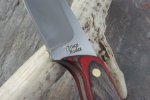- Joined
- Nov 30, 2011
- Messages
- 22
You got your new stamp to mark your blades. A custom makers mark that you are proud of. You take a hammer in hand and "bang" you have an impression, a bad one. Maybe you flinched, maybe coughed, maybe your wife/girl friend flashed you. It doesn't matter. What matters is you are going to have to hit it again. Don't hit it yet. A metal stamp doesn't cut an impression in the metal, it moves the metal out of the way. The blade you hit use to be flat, now it's not, and it's going to be real hard to line that sucker back up and hit it again. A double impression is more than likely. Take the blade to the bench, grab a sanding block with 400 grit paper and sand it flat. Not off, just flat. The stamp makes little ridges that are in the way. Sanding them off will allow the stamp to line back up, in some cases almost like a key. It takes 45-60 seconds of sanding. Now you can hit it again. Don't flinch this time.
Another thought before you hit it for the first time. Some times you will get a "bounce" and there will be scars to smooth out or remove. Simple scotch tape from the desk, one layer one each side, will cusion the bounce and keep most secondary scratches from being a problem. The stamp has enough force to bite through the tape, but the bounce does not, most of the time. Masking tape also can be used.
One last thing, and it's a simple thing, wipe off the anvil, rail road iron or other chunk of metal before striking. A small piece of grit or metal will leave it's own impression on the other side of the blade. A quick wipe will reduce head aches later.
I'm sure using a press would be the easiest fix in the long run, but until I spring for one of those, I got a hammer.
Another thought before you hit it for the first time. Some times you will get a "bounce" and there will be scars to smooth out or remove. Simple scotch tape from the desk, one layer one each side, will cusion the bounce and keep most secondary scratches from being a problem. The stamp has enough force to bite through the tape, but the bounce does not, most of the time. Masking tape also can be used.
One last thing, and it's a simple thing, wipe off the anvil, rail road iron or other chunk of metal before striking. A small piece of grit or metal will leave it's own impression on the other side of the blade. A quick wipe will reduce head aches later.
I'm sure using a press would be the easiest fix in the long run, but until I spring for one of those, I got a hammer.



